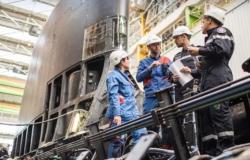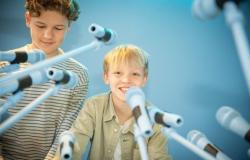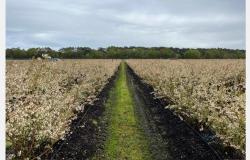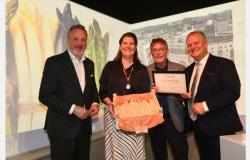Research into the proceeds of Serious Request, the Warmest Week and Viva for Life
The recruitment campaigns
- Recruitment campaign Serious Request was started in the Netherlands in 2004 by the radio station NPO 3FM. During the promotions, the radio station’s DJs stay in a Glass House.
- The campaign The Warmest Week in Flanders started in 2006. It is an annual campaign in a Glass House by the Belgian radio station Studio Brussels, and from 2022 also by MNM. Edition after edition, the campaign was increasingly supported by the other VRT channels.
- Viva for Life is a Walloon charity event, founded in 2013 by RTBF. Here too, three presenters lock themselves in a glass studio, called ‘the cube’.
Yield
Since 2017, the Flemish concept has achieved more revenue than the Dutch version, see graph 1. From 2018, this also applies to the Walloon variant. This is despite the fact that both Belgian regions have much fewer inhabitants than the Netherlands: 4.9 million people live in Wallonia, 6.8 million in Flanders and 17.9 million in the Netherlands. It is striking that the Flemish variant has been interrupted twice (2012 and 2020). This led to a significant drop in revenues.
Belgium has fewer inhabitants than the Netherlands – 11.7 million compared to 17.9 million respectively – but has been generating more revenue annually since 2016. When the average revenues per edition per country are compared, revenues appear to be higher in Belgium than in the Netherlands. Belgium generates an average result of 8.5 million euros per year compared to 5.8 million euros in the Netherlands, see graph 2.
René Bekkers (professor of philanthropy at VU Amsterdam): ‘The first law of fundraising is: if you don’t ask, you don’t get anything. The research ‘Giving in the Netherlands’ shows, among other things, that religious people give more than non-believers and that strict believers give more than believers.’ In concrete terms, this means that Protestants give more than Roman Catholics, at least to organizations and charities.
A special detail is that the five Serious Request editions in the Southern Netherlands (below the rivers), with the special nail polish campaign by Tijn Kosteren in 2016 in Breda, yielded more on average than the fifteen editions in the Northern Netherlands (above the rivers). That is an average of 7.7 million euros in the Southern Netherlands and 5.7 million euros per edition in the Northern Netherlands, respectively.

Who is more generous now?
Who is more generous now? With the exception of the years 2013 and 2014, Belgians, both Flemish and Walloon, give more per capita than the Dutch during the promotions in the week before Christmas. The Belgians are therefore more generous than the Dutch. As time goes on, the difference even increases. Even after the Flemish interruption in 2020, the amount per inhabitant remains higher than what the Dutch give. Below we will consider various explanations.
Culture and national character
The Dutch are a special people: headstrong, meddlesome, innovative and they have organized themselves in a detailed manner.1 They show above-average solidarity and are willing to do something together and for someone else, both in terms of time (volunteering) and in terms of giving behavior (donations and gifts). About eighty percent of Dutch people give time and/or money to others.2
According to the King Baudouin Foundation Barometer, 56 percent of Belgians donated to charities in 2022.3 The Belgian tax authorities (FPS Finance) reports that more than one million residents will have taken advantage of a tax reduction in 2022.4 Together they donated 350 million euros to charities.
In the French-speaking part, the percentage that gives (52 percent) is lower than in the Flemish-speaking part (59 percent). French speakers more often see support as a responsibility of the state. Perhaps a cultural influence from their southern neighbors, France.
Transmitter range
The market share of the radio station 3FM influences the revenue.5 The increase in revenue over the past year, for example, is due to 3FM’s significantly increased market share during the promotional week. At 4.1 percent, it is noticeably higher than the week before (1.8 percent). More listeners, more givers.
Until 2018, the autumn campaign in Flanders was a solo project by Studio Brussels. When the number of channels increased, the reach and therefore the revenues increased significantly. In Wallonia, the RTBF radio station will have a market share of 12.8% in spring 2023.6 This reach is three times as large as in the Netherlands and one and a half times as large as in Flanders.
Concept
The design of the autumn campaigns in the Netherlands and Belgium has changed several times over the years.
Goals
Until 2020, Serious Request was a campaign in collaboration with the Red Cross to raise money for international aid. In 2021, the switch was made to the World Wildlife Fund (environment, nature and animals). In 2022, the channel chose a national charity for the first time, Het Vergeten Kind (social & social goals). Last year, money was raised for the ALS Netherlands Foundation (health). Since this adjustment in spending, revenues have been growing again. In the Netherlands, unlike the Flemish, the organizers have continued to stick to one charity per year.
The Warmest Week in Flanders started in 2006. Until 2012, there was annual cooperation with the Red Cross-Flanders, following the example of the Dutch Serious Request, and there was a Glass House. In 2013, we switched to collaboration with the King Baudouin Foundation. This coordinated the charities for which recruitment took place. The foundation increasingly opted for regional and local charities and local actions. This change led to sharply increasing revenues with an absolute peak in 2018 and 2019.
Viva for Life is a Walloon charity event, founded in 2013 by RTBF, that raises money for one theme: combating child poverty in French-speaking Belgium. To do this, three presenters from VivaCité radio, like their colleagues from the Netherlands and Flanders, lock themselves in a glass studio called ‘the cube’. The yields here show a continuous upward trend without interruption.
Since Serious Request focuses on national goals, revenues are growing again
Continuity and concept
From the start, the Glass House has been the focus of the recruitment campaign in the Netherlands. Between 2018 and 2020 this temporarily changed to walks through the country and use of a warehouse in Twente. In 2021, however, the Glass House has returned as the center of attention.
Flanders also started with a Glass House. In 2013, the Flemish people exchanged the Glass House for an outdoor studio. In Flanders, the autumn campaign started in 2006 and was interrupted twice, in 2012 and 2020. The interruptions resulted in a serious reduction in yields.
The action in Wallonia also started with a Glass House. This concept has remained unchanged to this day. The action has also never been interrupted. Revenues show a continuous upward trend.
The conclusion is justified that continuity of the campaign and the concept is important for awareness, sympathy and revenues.
Displacement/substitution
With the exception of 2013 and 2014, both Flemish and Walloon people give significantly more per capita than the Dutch. Perhaps a role is played by the fact that, in addition to Serious Request, there are more large-scale and well-known donation campaigns in the Netherlands, such as Alpe d’HuZes and the Roparun. There are fewer such large, well-known promotions in Belgium and the proceeds may therefore be higher for this specific promotion. You can only give away a euro once.
Does Serious Request need an overhaul?
Despite the smaller number of inhabitants, the interrupted continuity, the younger versions of the campaigns and the less present giving culture, Walloons and Flemish people have achieved greater returns with the autumn campaign than in the Netherlands, especially since 2016. Reasons could be the greater reach of the channels, less competition from other national giveaways or adjustments in spending.
In 2017, the Flemish organizers expressed strong criticism of the Dutch variant: ‘You have to keep innovating,’ was the message.7 That has hardly been done in the Netherlands. Most important change: switching from international aid (from 2004 to 2021) to national goals (2022 and 2023). In Belgium, people have started donating to regional and local causes earlier.
From 2013 onwards, Dutch yields have shown a declining trend, while Belgian results have actually increased. Since 2016, the Dutch results have even been largely surpassed by the Belgians, even though 35 percent fewer people live there. This is striking when you consider that, according to the ‘Giving in the Netherlands’ study, the Dutch are more willing to give than their southern neighbors.
Paul Smeets (professor of philanthropy, University of Amsterdam): ‘Serious Request could consistently focus on reducing poverty, just like the Belgians. Donate three-quarters of the money to local poverty and a quarter to solving extreme poverty worldwide, paying attention to the most effective charities.’
What can Serious Request do to turn the tide? Expand the reach of Serious Request by improving marketing. Move on from international goals via national goals to regional and local goals that people recognize. Collaborate with regional and local broadcasters. They have a wide reach and are in touch with community life that takes place and takes place in relative silence. The future is local!8
Endnotes
- Opinion article BrabantsDagblad, 8-12-2018. https://www.lokalegoededoelengids.nl/media/i5lm1a0l/16-12-08-bijzonder-volkje-3.pdf
- VU – Giving in the Netherlands, 2022. Walburg Press, Amsterdam.
- King Baudouin Foundation – Barometer of Philanthropy 2023 – 7th edition, 2023. Brussels. https://media.kbs-frb.be/nl/media/10608/Presentatie%207de%20Barometer%2023
- Fondsenwerf.nl – ‘Belgian Tax Authorities: ‘Donations to charities record high”, 9-1-2024. https://vakbladfw.nl/3uIKv83
- https://www.spraakbuis.nl/ Listening Figures-npo-3fm-vanaflopen-20-jaar/
- The exact correlation between the reach of Flemish and Walloon channels and revenues can be checked via https://www.cim.be/nl/
- NOS News, 19-12-2017 (nos.nl): https://vakbladfw.nl/48pcHdO
- De Rond, J, and Meijs, L, – ‘The future is local’, Platform for Voluntary Deployment, June 2021 https://volunteerwerk.nl/nieuws+en+blogs/1978040.aspx?t=De-toekomst-is- local-cherish-and-explore-local-community-life
—
This article previously appeared in Fundraising Vakblad, volume 26, number 1, which appeared in April 2024.
Tags: Wallonia Flanders generous Netherlands
-







